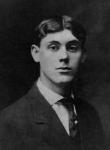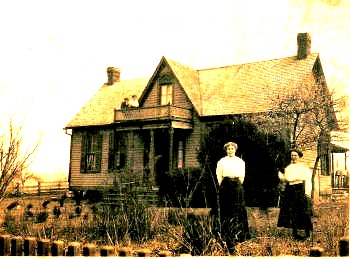In a letter from Albert to his mother in
December 1910, he tells her he has met a Miss
McCamy who was a teacher at Cookson Creek. The
McCamy's were living in the old house at this
time having moved from Young-Harris, Georgia at
the end of 1909.
The farm was originally over
100 acres, with the northern border being Horns
Creek road and the southern 30 acres or so sold
to "Aunt Lou", Mary Louise Rymer Miles and her
husband Ed Miles. Frances parents sold the farm
to Frances's sister Lena and her husband, Bob
Ervin. In 1933, Frances bought the house and 50
plus acres from the Ervins, the Ervins kept the
northern part of the property.
THE HOUSE in the photo above (c.a. 1909)
appears much as it did when built. The roof over
the front porch was flat and had a railing which
could be used as a deck, it was changed to the
sloped roof it has today after Frances bought it
in 1933. Entrance was made through the door
looking like two long windows. Also the original
roof was wooden shingles some of which were not
replaced until the late 1930's. The floor plan
was in the shape of a "T", two rooms, a hall and
a stairway forming the front as shown here. The
hallway ended at the entrance to the third room
which completed the bottom of the "T". The room
at the bottom of the "T" had a porch on each
side conatining a cistern to catch the water off
the roof. In the photo the south porch is
visable. All downstairs rooms had fireplaces.
Upstairs the layout was similiar with the
exception being the outside walls were only one
story high, this meant the upstairs rooms were
much smaller and had sloping ceilings starting
about 3 feet from the floor and only a few feet
of flat space at the top. The two "front" rooms
had about 30 inch paneling and all rooms were
plaster over hand split wooden lathes. There was
the front porch shown in the photo and a porch
on the south side of the "back" room. Albert
later added a room to the back of the "back"
room for a kitchen. Harry and Kathy modified the
"back" room to include much of the south porch.
Probably in the 1920's a Delco plant was
installed and an addition was made adding a
bathroom to the north side of the "back" room.
THE BARN was 40 by 60 feet and 3 stories high.
It was made of hand hewn logs, the largest 12 by
12 inches and up to 40 feet long. The main
timbers were held together with large wooden
pegs. The west end of the barn had I. S. Mc. and
1877 cut into the boards. This was the initials
of the owner and stood for I. S. McCash and the
year it was finished, 1877. Oral history was the
house was built after the barn, so the house was
probably finished in 1878 or 79.

The Old Barn in the
background with two of the
granddaughters washing and rinsing
their hair by pumping water from the
cistern on the north porch and
pouring it over the others head. The
peak of the roof of the old corn
crib appears in the left portion of
the photo.
|
The bottom story of the barn had a low ceiling
and contained stables for animals. The middle
floor contained stables for horses and a tack
room on the west side. the center was open so a
horse and wagon filled with hay could be pulled
in for unloading, (the north side of the barn
was naturally higher than the south). The east
side of the second story was used for hay
storage. There were openings in the floor where
hay could be dropped directly into the stables
below. The third story only covered the western
half of the barn and was used as a hayloft to
store hay.
When first built the hay had to be hand
unloaded from a wagon then moved to the back or
side of the loft. Before Albert and Frances
moved to Georgia, Albert had added a kitchen to
the "back" room and also added a wooden track to
the top of the barn. This track had a four
wheeled trolley which could be locked in the
center of the barn. A long rope ran through the
trolley to the west side of the barn through
another pulley, down to almost the ground and
then out to where horses could be hooked to it.
The purpose was simple, a load of hay would be
brought into the barn and a 30 inch of so tool
was inserted and opened up like a harpoon. One
end of the rope was attached to the trolley and
through a pulley which dropped down and was
attached to the harpoon. A signal was given and
the horse(s) would start pulling the rope on the
other end. Up would come the harpoon with as
much as 300 - 400 pounds of hay. When the pulley
attached to the harpoon hit the trolley it would
unlock and everything would run out the track.
The person in the barn would determine where he
wanted to drop the hay and pull a rope attached
to the harpoon which would drop the load of hay.
He then would pull the empty trolley back and
repeat the process if needed. This saved a lot
of hard, hot, work in unloading hay .
THE PRE CIVIL WAR HOUSE: There was a house on
the farm, (very close to where Danny Frazier
lives now -2009), before the Civil War. You
could see remains of the housesite in the 1940's
and maybe today. The reason this is included is
it has a story. Polk County did not have any
Civil War battles. However, persons formed their
little private armies, a fellow named Gatewood
was one of them. Gatewood was a self appointed
assassin of Union sympathizers; plundering,
robbing and killing. He came through Polk County
and the house in question looking for the man of
the house, who had hidden in a box of cotton.
The premises were searched but they did not find
him and so he escaped. Others were not so lucky,
"The Heritage of Polk County" lists several
others who were killed by Gatewood and his men.
Back to Married Life



